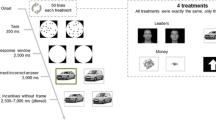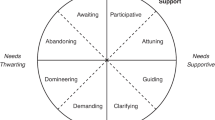Abstract
Three experimental studies tested whether a priming procedure intended to activate an autonomy orientation would lead to nondefensiveness and enhanced performance, whether activated control orientation would lead to higher defense and impaired performance, and whether activated impersonal orientation would lead to the greatest defense and worst performance. Study 1 showed that autonomy-primed participants report lower desire for escape compared to control-primed, and that impersonally-primed showed most desire to escape. In Study 2, autonomy-primed participants showed the least self-serving bias, control-primed were in the middle, and impersonally-primed participants showed the most. In Study 3, rowers autonomy-primed showed the least self-handicapping and best performance, control-primed showed moderate levels, and impersonally-primed showed the most self-handicapping and worst performance. Results are discussed in terms of motivation orientation, defensiveness, and performance.

Similar content being viewed by others
Notes
An estimate of effect size, the Pearson r, was computed as: \(r = \sqrt{\frac{F(1,\_)}{F(1,\_) + df_{{\rm error}}}}\) (Rosenthal & Rosnow, 1984). The magnitude of the effect is indicated by r 2, an estimate of the variance accounted for. According to Cohen and Cohen (1983, p. 61) rs of .10, .30, and .50 correspond to small, medium, and large effects, respectively. According to Rosenthal and Rubin (1982), the real-life implication of effect sizes can be illustrated with the Binomial Effect Size Display, in which r is identical to an increase in success rates obtained. For example, an r of .32 would be associated with an increase in survival rates from 18% with Drug A to 50% with Drug B.
When the single items were analyzed individually, the Motivation Prime linear contrast for the desire to sleep item was significant, F (1, 59)=4.81, p < .05, r < .27, for the desire to leave item was marginally significant, F(1,59)=3.94, p < .065, r < .25, and for the desire to use alcohol showed no effect, F(1, 51)=1. The number of participants who smoked was very small (N=19) so the analysis on the single smoke item was not significant, F(1,18)=2.03, p < .18 r < .32, (Ms=7.07, 9.54, 9.67 for autonomy, control, and impersonal). However, despite the lack of significance, the impressive effect size suggests that 10% of the desire to smoke (r 2=.10) is accounted for by motivation orientation. It suggests that feeling control and especially impersonally oriented is an important trigger for smoking. It would be interesting to examine this in the future with a large sample of smokers to see if the effect is reliable.
Analyses that use internal and external attribution scores as a repeated measure show the identical pattern as the ones we report for self-serving attribution scores.
Participants in Study 3's two samples did not differ significantly on the number of years of rowing experience or on any dependent variable, all Fs < 2.
Due to experimenter error, two males in Sample 2 of Study 3 rowed 500 m instead of 2000 m. The performance measures were estimated for these two rowers by adding 13.1 s to their estimated and actual times for the 500 m distance. This adjustment was based on data from male rowers at Florida Tech who rowed two ergometer races in a single day, one 500 m and one 2000 m; 13.1 s was the average time differential between the 500 and 2000 m distance, across heavyweight and lightweight rowers.
Separate analyses of the Claimed and Constructed Self-Handicapping subscales also were significant, both Fs < 4.35, both ps < .05, both rs >.30.
References
Bargh, J. A. (1992). Does subliminality matter to social psychology? Being aware of the stimulus versus aware of its influence. In R. F. Bornstein & T. Pittman (Eds.), Perception without awareness (pp. 236–255). New York: Guilford Press.
Bargh, J. A., Chen, M., & Burrows, L. (1996). Automaticity of social behavior: Direct effects of trait construct and stereotype activation on action. Journal of Personality and Social Psychology, 71, 230–244.
Baumeister, R. F. (1990). Anxiety and deconstruction: On escaping the self. In J. M. Olson & M. P. Zanna (Eds.), Self-inference processes: The Ontario Symposium, Vol. 6. (pp. 259–291). Hillsdale, NJ: Lawrence Erlbaum Associates.
Brown, K. W., & Ryan, R. M. (2003). The benefits of being present: Mindfulness and its role in psychological well-being. Journal of Personality and Social Psychology, 84, 822–848.
Carver, C. S., & Scheier, M. F. (1981). Attention and self-regulation: A control-theory approach to human behavior. New York: Springer-Verlag.
Cioffi, D., & Holloway, J. (1993). Delayed costs of suppressed pain. Journal of Personality and Social Psychology, 64, 274–282.
Cohen, J., & Cohen, P. (1983). Applied multiple regression/correlation analysis for the behavioral sciences. Hillsdale, NJ: Lawrence Erlbaum Associates, Publishers.
Colvin, C. R., & Block, J. (1994). Do positive illusions foster mental health? An examination of the Taylor and Brown formulation. Psychological Bulletin, 116, 3–20.
Connole, I., & Hodgins, H. S. (2006). Impact of primed motivation orientations on anaerobic physical performance. Unpublished manuscript.
Deci, E. L., & Ryan, R. M. (1985). The general causality orientations scale: Self-determination in personality. Journal of Research in Personality, 19, 109–134.
Deci, E. L., & Ryan, R. M. (1995). Human autonomy: The basis for true self-esteem. In M. H. Kernis (Ed.), Efficacy, agency, and SE (pp. 31–49). New York, NY: Plenum Press.
Dovidio, J. F., Kawakami, K., Johnson, C., Johnson, B., & Howard, A. (1997). On the nature of prejudice: Automatic and controlled processes. Journal of Experimental Social Psychology, 33, 510–540.
Duval, S., & Wicklund, R. A. (1972). A theory of objective self-awareness. New York: Academic Press.
Fazio, R. H., Sanbonmatsu, D. M., Powell, M. C., & Kardes, F. R. (1986). On the automatic activation of attitudes. Journal of Personality and Social Psychology, 50, 229–238.
Greenberg, J., Pyszczynski, T., & Solomon, S. (1995). Toward a dual-motive depth psychology of self and social behavior. In M. H. Kernis (Ed.), Efficacy, agency, and self-esteem (pp. 73–99). New York, NY: Plenum Press.
Grolnick, W. S., & Ryan, R. M. (1987). Autonomy in children's learning: An experimental and individual difference investigation. Journal of Personality and Social Psychology, 52, 890–898.
Hausenblas, H. A., & Carron, A. V. (1996). Group cohesion and self-handicapping in female and male athletes. Journal of Sport and Exercise Psychology, 18, 132–143.
Hirt, E. R., Deppe, R. K., & Gordon, L. J. (1991). Self-reported versus behavioral self-handicapping: Empirical evidence for a theoretical distinction. Journal of Personality and Social Psychology, 61, 981–991.
Hodgins, H. S. (2006). Autonomy and self-integration. Manuscript under review.
Hodgins, H. S., Brown, A. B., & Carver, B. (in press). Autonomy and control motivation and self-esteem. Self and Identity.
Hodgins, H. S., & Knee, C. R. (2002). The integrating self and conscious experience. In E. L. Deci & R. M. Ryan (Eds.), The handbook of self-determination research (pp. 87–100). Rochester, NY: University of Rochester Press.
Hodgins, H. S., Koestner, R., & Duncan, N. (1996). On the compatibility of autonomy and relatedness. Personality and Social Psychology Bulletin, 22, 227–237.
Hodgins, H. S., & Liebeskind, E. (2003). Apology versus defense: Antecedents and consequences. Journal of Experimental Social Psychology, 39, 297–316.
Hodgins, H. S., Liebeskind, E., & Schwartz, W. (1996). Getting out of hot water: Facework in social predicaments. Journal of Personality and Social Psychology, 71, 300–314.
Horney, K. (1950). Neurosis and human growth. NewYork: W. W. Norton & Co., Inc.
Hull, J. G. (1981). A self-awareness model of the causes and effects of alcohol consumption. Journal of Abnormal Psychology, 90, 586–600.
Judd, C. M., & Kenny, D. A. (1981). Process analysis: Estimating mediation in treatment evaluations. Evaluation Review, 5 602–619.
Knee, C. R., Lonsbary, Canevello, & Patrick, H. (2005). Self-determination and conflict in romantic relationships. Journal of Personality and Social Psychology, 89, 997–1009.
Knee, C. R., & Zuckerman, M. (1996). Causality orientations and the disappearance of the self-serving bias. Journal of Research in Personality, 30, 76–87.
Knee, C. R., & Zuckerman, M. (1998). A nondefensive personality: Autonomy and control as moderators of defensive coping and self-handicapping. Journal of Research in Personality, 32, 115–130.
Knee, C. R., Patrick, H., Vietor, N. A., Nanayakkara, A., & Neighbors, C. (2002). Self-determination as growth motivation in romantic relationships. Personality and Social Psychology Bulletin, 28, 609–619.
Levesque, C., & Pelletier, L. G. (2003). On the investigation of primed and chronic autonomous and heteronomous motivational orientations. Personality and Social Psychology Bulletin, 29, 1570–1584.
Lonky, E., & Reihman, J. M. (1990). Self-regulation and moral reasoning as mediators of moral behavior. Unpublished manuscript, Department of Psychology, State University of New York at Oswego, Oswego, NY.
McKirnan, D. J., Ostrow, D. G., & Hope, B. (1996). Sex, drugs and escape: A psychological model of HIV−risk sexual +behaviors. AIDS Care, 8, 655–669.
Mendolia, M., & Kleck, R. E. (1993). Effects of talking about a stressful event on arousal: Does what we talk about make a difference? Journal of Personality and Social Psychology, 64, 283–292.
Moskalenko, S., & Heinke, S. J. (2003). Watching your troubles away: Television viewing as a stimulus for subjective self-awareness. Personality and Social Psychology Bulletin, 29, 76–85.
Ntoumanis, N. (2005). A prospective study of participation in optional school physical education using a Self-Determination Theory framework. Journal of Educational Psychology, 97, 444–453.
Neighbors, C., Vietor, N. A., & Knee, C. R. (2002). A motivational model of driving anger and aggression. Personality and Social Psychology Bulletin, 28, 324–335.
Paulhus, D. L. (1998). Interpersonal and intrapsychic adaptiveness of trait self-enhancement: A mixed blessing? Journal of Personality and Social Psychology, 74, 1197–1208.
Richards, J. M., & Gross, J. J. (1999). Composure at any cost? The cognitive consequences of emotion suppession. Personality and Social Psychology Bulletin, 25, 1033–1044.
Robins, R. W., & Beer, J. S. (2001). Positive illusions about the self: Short-term benefits and long-term costs. Journal of Personality and Social Psychology, 80, 340–352.
Rosenthal, R., & Rosnow, R. L. (1984). Essentials of behavioral research: Methods and data analysis. New York: McGraw-Hill.
Rosenthal, R., & Rubin, D. B. (1982). A single, general purpose display of magnitude of experimental effect. Journal of Educational Psychology, 74, 166–169.
Ryan, R. M. (1995). Psychological needs and the facilitation of integrative processes. Journal of Personality, 63, 397–427.
Ryan, R. M., & Deci, E. L. (2000). Self-determination theory and the facilitation of intrinsic motivation, social development, and well-being. American Psychologist, 55, 68–78.
Ryan, R. M., Frederick, C. M., Lepes, D., Rubio, N., & Sheldon, K. M. (1997). Intrinsic motivation and exercise adherence. International Journal of Sports Psychology, 28, 335–354.
Suls, J., & Fletcher, B. (1985). The relative efficacy of avoidant and nonavoidant coping strategies: A meta-analysis. Health Psychology, 4, 249–288.
Taylor, S. E., & Brown, J. D. (1988). Illusion and well-being: A social psychological perspective on mental health. Psychological Bulletin, 103, 193–210.
Wann, D. L., & Schrader, M. P. (2000). Controllability and stability in the self-serving attributions of sport spectators. Journal of Social Psychology, 140, 160–168.
Williams, G. C., & Deci, E. L. (1996). Internalization of biopsychosocial values by medical students: A test of self-determination theory. Journal of Personality and Social Psychology, 70, 767–779.
Zuckerman, M., Gioioso, C., & Tellini, S. (1988). Control orientation, self-monitoring, and preference for image versus quality approach to advertising. Journal of Research in Personality, 22, 89–100.
Zuckerman, M., & Lubin, B. (1965). Manual for the Multiple Affect Adjective Check List: Today Form. San Diego, CA: Educational and Industrial Testing Service.
Acknowledgments
The authors wish to thank Coach Jim Tucci and the Skidmore College women and men's crew teams for participating in Study 3 with such generosity and good-nature, and to offer our admiration for people who get out on Saratoga Lake so very early. Many thanks also to Marc Mandel, the men's rowing coach at the Florida Institute of Technology, for providing data and the rowing times for use in Study 3. This research was supported by a Skidmore College Faculty Award for Major Project Completion awarded to the first author during the summer of 2003.
Author information
Authors and Affiliations
Corresponding author
Rights and permissions
About this article
Cite this article
Hodgins, H.S., Yacko, H.A. & Gottlieb, E. Autonomy and Nondefensiveness. Motiv Emot 30, 283–293 (2006). https://doi.org/10.1007/s11031-006-9036-7
Published:
Issue Date:
DOI: https://doi.org/10.1007/s11031-006-9036-7




